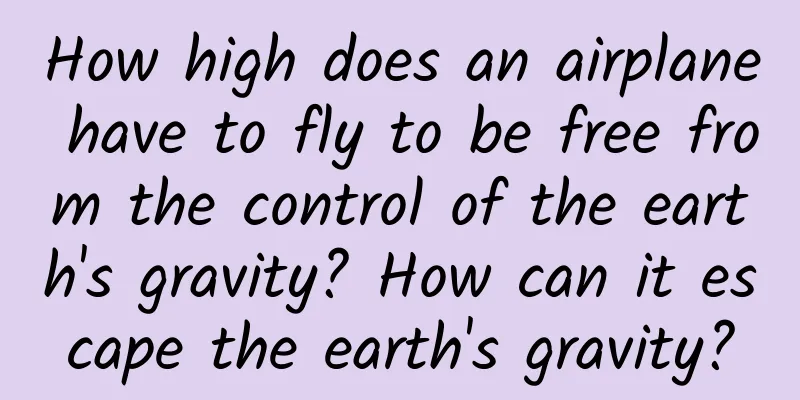How high does an airplane have to fly to be free from the control of the earth's gravity? How can it escape the earth's gravity?

|
People are full of fantasies about flying, and there are many such questions on the Internet. For example, the earth is rotating, and as long as the plane flies in the air and does not move, it will circle the earth once a day, which saves fuel and energy. There have been many answers to such questions in the past. Friends who are interested can refer to the relevant articles published by Space-Time Communication earlier, so I will not go into details. Today, let’s talk about the question raised by some netizens: How high should the plane fly to be free from the influence of the earth’s gravity? No matter how high a plane flies, it is still restrained by the earth's gravity. Because planes rely on aerodynamics to fly, they move in the atmosphere. Once they leave the atmosphere, they will lose the support of the air, and the two wings and tail will be useless, and they will fall. In addition, the plane's engine also needs oxygen to maintain its operation. If the engine is too high in the air, it will shut down due to lack of oxygen, and it will also fall. The fastest and highest flying aircraft at present is the X-15A test aircraft of the United States in the 1960s, with a flight speed of 6.72 Mach (7274km/h) and a maximum flight altitude of 108,000 meters. This is just like the saying of Sun Wukong, "108,000 miles", but here it is only 108,000 kilometers. However, this aircraft can no longer be completely regarded as an aircraft. It is powered by a rocket engine developed by North American Aviation. Strictly speaking, it is a bit like a rocket. Why can a rocket fly higher into space? It is because it is equipped with a rocket engine, which does not require oxygen for combustion. Its fuel is equipped with flame retardants, such as a 2:1 mixture of liquid hydrogen and liquid oxygen, which is equivalent to carrying its own oxygen for combustion. Moreover, the rocket does not rely on air to lift it up, but relies on the reaction force to eject hot and high-speed gas downward or backward to propel itself. In theory, as long as there is enough fuel, it can keep flying. At this time, the air in the atmosphere becomes resistance, so in the future, more and more spacecraft flying to deep space will be launched from space or the moon, because there is no atmospheric resistance there and the influence of gravity is smaller. Gravity is a long-range force, and in theory it acts infinitely far. No matter how far you fly, you will be able to fly out of the earth's gravity. There is probably no limit to this. Because gravity theoretically acts infinitely far, even at the edge of the sky and the universe, the earth's gravity is still there, which means it is impossible to completely fly out of the earth's gravity. But gravity is also a weak force, and its magnitude is proportional to mass and inversely proportional to the square of the distance. The formula it follows is: F=GMm/r^2. Here, F represents the magnitude of gravity, G is the gravitational constant, M and m represent the mass of the two objects interacting with each other, and r is the distance between the two objects. From the formula, we can see that the greater the mass of the two interacting objects, the greater the gravity, and the greater the distance, the greater the gravity decays, and it decays in a square order. In this way, when the distance is far, the gravity is very weak. There are various celestial bodies in space, and their gravitational pull affects each other. So although the gravitational pull can reach infinity, this infinity is only symbolic. It is very weak at a certain distance and difficult to feel and measure. In this way, according to the mass of different celestial bodies and the interaction between celestial bodies, the gravitational pull of each celestial body has an influence range. Within this range, the gravitational pull can act on its attached objects, and outside this range, it cannot affect them. This range is called the Hill sphere radius. The calculation formula for the Hill sphere radius is: r = a*cubic root [m/(3*M)] Where r is the radius of the Hill sphere, m is the mass of the object in the Hill sphere being calculated, M is the mass of the large object that affects the orbit of m, and a is the semi-major axis of m's orbit. According to this formula, the radius of the Earth's Hill sphere is about 1.5 million kilometers, which means that within a spherical range of 1.5 million kilometers, the Earth's gravity plays a controlling role. If it is beyond 1.5 million kilometers, the Earth has no control. The Moon is about 384,000 kilometers away from us on average, so it is completely under the control of the Earth and can only revolve around the Earth. The radius of the moon's Hill sphere is about 61,400 kilometers. Within this range from the moon, small celestial bodies are restrained by the moon's gravity, while in this marginal area, the gravity of the earth and the moon creates a balance. The Sun-Earth Lagrange points are several points 1.5 million kilometers from the Earth, where the Earth's gravity and the Sun's gravity reach a balance. In theory, artificial celestial bodies there do not need fuel or very little fuel to stay for a long time. In fact, many detectors and space telescopes in the world operate at these locations. The Queqiao relay satellite launched by my country in 2019 is the first spacecraft to operate at the Earth-Moon Lagrange point L2. So strictly speaking, any aircraft must fly 1.5 million kilometers to escape the Earth's gravity. Airplanes are no exception, but not only can they not escape the Earth's gravity, they can't even fly out of the 16-kilometer troposphere of the Earth's atmosphere. To escape the control of the earth's gravity, you must reach a certain speed. Einstein's general theory of relativity believes that the essence of gravity is the disturbance and distortion of the surrounding space-time caused by mass. The result of this distortion is that the large mass celestial body is surrounded by gravitational vortexes or traps. To escape this vortex or trap, you must run fast, just like escaping from a whirlpool in the sea, you must drive the boat very fast to escape. Therefore, to escape gravity, you must reach a certain speed. The greater the gravity, the faster the speed required. In other words, the faster the speed, the faster you can escape the clutches of gravity. The above picture vividly illustrates the method of escaping gravity: Einstein pedaled hard on his bicycle to avoid falling into the gravity trap. Based on the gravitational formula, scientists have derived three cosmic speeds on Earth, namely, the first cosmic speed, 7.9 kilometers per second, also known as the orbital speed; the second cosmic speed, 11.2 kilometers per second, also known as the escape speed; the third cosmic speed, 16.7 kilometers per second, also known as the escape speed. When the first cosmic velocity is reached, it is possible to counteract the gravity of the earth. One will neither be pulled down by the earth's gravity nor escape the control of the earth's gravity. Current artificial satellites, space stations, space observatories (space telescopes) and other artificial celestial bodies are launched at this speed. When the second cosmic velocity is reached, it is possible to escape the earth's gravity and fly to a space beyond the 150-kilometer radius of the Earth's Hill sphere to visit other planets. All probes heading for Mars, Venus, Jupiter, Saturn and other planets must travel at a speed greater than this. When the third cosmic velocity is reached, it is possible to escape the gravity of the sun and fly beyond the solar system. Now, Voyager 1 is flying out of the solar system at a speed of about 17 kilometers per second. It is more than 22.3 billion kilometers away from us, making it the farthest-flying probe ever flown by humans. The escape velocity of a celestial body is called the escape velocity. Although the second cosmic velocity of 11.2 km/s is called the escape velocity, it is actually the escape velocity of the earth. In fact, each celestial body has its own escape velocity. The formula for calculating this velocity is: v=√(2GM/R) Here, v is the escape velocity, G is the gravitational constant, M is the mass of the escaped celestial body, and R is the radius of the celestial body. This formula is used to calculate the escape velocity of all celestial bodies. The escape velocity of any celestial body can be calculated according to this formula. For example, according to this formula, as long as the speed reaches 617.7km/s, you can escape the sun's gravity. This escape velocity refers to the speed required to escape from the surface of a celestial body. If you are already a certain distance away from the celestial body, according to the formula of the law of gravity, the gravity has already decayed a lot, so the escape velocity does not need to be that high. For example, at the Earth's location 150 million kilometers away from the Sun, the escape velocity from the Sun is only about 42 km/s, while the Earth's orbital velocity is 29.8 kilometers per second. If a spacecraft is launched here and with the help of the Earth's orbital force, it only needs 16.7 km/s to escape both the Earth's gravity and the Sun's gravity. The third cosmic velocity calculation formula is: v=√(v'^2+v"^2) v is the third cosmic velocity; v' is the Earth's escape velocity - orbital velocity 42.2-29.8=12.4km; v" is the second cosmic velocity. Therefore, no matter how high an airplane flies, it cannot escape the earth's gravity. There is no airplane that is not restrained by the earth's gravity. However, if a spacecraft wants to fly out of the earth's gravity, it must obey the law of gravity and reach the second cosmic speed. Once it flies 150 kilometers away from the earth, it will escape the earth's gravity. That’s it, welcome to discuss, thanks for reading. The copyright of Space-Time Communication is original. Infringement and plagiarism are unethical behavior. Please understand and cooperate. |
<<: How difficult is it for Tianwen-1 to accomplish three major tasks at one time?
Recommend
The prototype of the king in the night is actually an amazed expression pack! !
Beijing Temple of Heaven Park is an important hab...
How much does it cost to produce Zhangye Printing Mini Program? Zhangye printing and printing applet production price inquiry
In order to better penetrate into various industr...
iOS 16.2 finally supports 120Hz high refresh rate!
The day before yesterday, Apple pushed the iOS 1...
"Air-to-Air Power-On" Race: China's Aviation Industry Enters the Era of Air-to-Air Internet Access
The first portable electronic device (PED) open f...
Ignoring the failure of MEGA, Ideal will launch five more pure electric models next year, not only because of policy risks
In August 2024, Ideal Auto's delivery volume ...
How does the Shenzhen Financial Mini Program work? How to promote financial WeChat mini-programs?
With the development of mobile Internet, finance ...
What is hidden on the back of the moon?
Question: What is on the back of the moon? Copyri...
How much does it cost to customize a pet mini program in Tumushuke?
More and more businesses are paying attention to ...
Electric Technology Car News: Can a high-end Emgrand GL with a price of 80,000 yuan beat joint venture cars in the compact family car segment?
Emgrand, a name that seems to be full of petty bo...
Is it true that pregnant women eating goose eggs can prevent jaundice in their babies?
Rumor: "Pregnant women eating goose eggs can...
World Love Beans Day! Beans, how come you are so outstanding?
February 10th is the fifth "World Pulses Day...
Chinese Traditional Medicine Day | Do you know who are the top ten famous doctors in Chinese history?
END Editor: Guru...
Super practical! A comprehensive guide to the APP design process from a master's personal notes
Today's translation is full of useful informa...
Fruits and vegetables that you can’t miss in autumn, eat more of them for good health!
Editor's Note In autumn, the weather will gra...
Unfortunately passed away! A woman with cancer did not go to the hospital for treatment, but... Many people are still unaware of these misunderstandings
Expert of this article: Hu Zhongdong, deputy chie...









